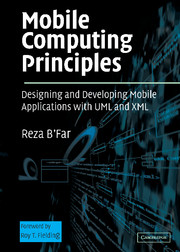Book contents
- Frontmatter
- Contents
- Foreword by Roy T. Fielding
- Acknowledgments
- SECTION 1 INTRODUCTIONS TO THE MAIN TOPICS
- SECTION 2 DEVICE-INDEPENDENT AND MULTICHANNEL USER INTERFACE DEVELOPMENT USING UML
- SECTION 3 ADDITIONAL DIMENSIONS OF MOBILE APPLICATION DEVELOPMENT
- Chapter 9 Mobile Agents and Peer-to-Peer Architectures for Mobile Applications
- Chapter 10 Wireless Connectivity and Mobile Applications
- Chapter 11 Synchronization and Replication of Mobile Data
- Chapter 12 Mobility and Location-Based Services
- Chapter 13 Active Transactions
- Chapter 14 Mobile Security
- SECTION 4 PUTTING THE PROJECT TOGETHER
- References
- Index
Chapter 13 - Active Transactions
from SECTION 3 - ADDITIONAL DIMENSIONS OF MOBILE APPLICATION DEVELOPMENT
Published online by Cambridge University Press: 03 September 2009
- Frontmatter
- Contents
- Foreword by Roy T. Fielding
- Acknowledgments
- SECTION 1 INTRODUCTIONS TO THE MAIN TOPICS
- SECTION 2 DEVICE-INDEPENDENT AND MULTICHANNEL USER INTERFACE DEVELOPMENT USING UML
- SECTION 3 ADDITIONAL DIMENSIONS OF MOBILE APPLICATION DEVELOPMENT
- Chapter 9 Mobile Agents and Peer-to-Peer Architectures for Mobile Applications
- Chapter 10 Wireless Connectivity and Mobile Applications
- Chapter 11 Synchronization and Replication of Mobile Data
- Chapter 12 Mobility and Location-Based Services
- Chapter 13 Active Transactions
- Chapter 14 Mobile Security
- SECTION 4 PUTTING THE PROJECT TOGETHER
- References
- Index
Summary
People demand freedom of speech as a compensation for the freedom of thought which they seldom use!
Søren KierkegaardINTRODUCTION
We have used the term active transactions in this text only for the lack of a better term that encapsulates the active participation of a computing system in interacting with the user. What we refer to as active transactions in this text includes all those behaviors exhibited by the system that are started autonomously by the application without the immediate and synchronous invocation of the software by the user. A subset of active transactions is often referred to as push-based technologies. Although the term “push” is better used in defining the implementation of the application, one part of the application could “poll” or “pull” and still exhibit active participation in interacting with the user.
What is important to note right away is that active transactions are not limited to push. Let us look at some examples of what we may mean by active transactions:
An active mobile application that collects end-of-day field results can scan through the records of a salesperson's visits and if he or she has failed to fill out a time sheet with the appropriate visits, the application locates the salesperson by contacting him or her at all pertinent contact points. For example, the application may call the salesperson on the phone and ask him or her to say how many hours were worked and where the work was performed. The salesperson may have simply forgotten to log his or her hours; this process would not only contact the salesperson but also give the salesperson the opportunity to provide the required information during the same session. […]
- Type
- Chapter
- Information
- Mobile Computing PrinciplesDesigning and Developing Mobile Applications with UML and XML, pp. 723 - 734Publisher: Cambridge University PressPrint publication year: 2004

